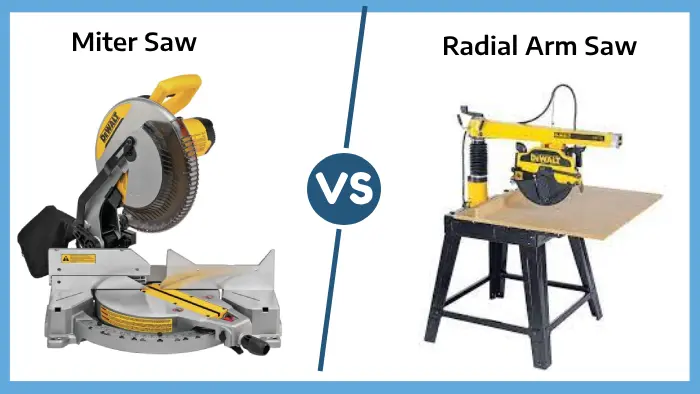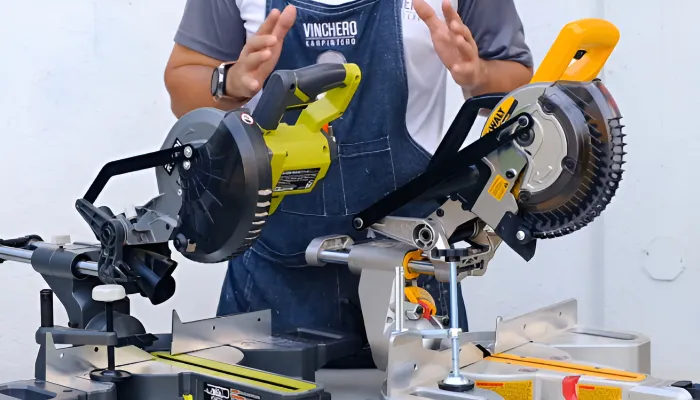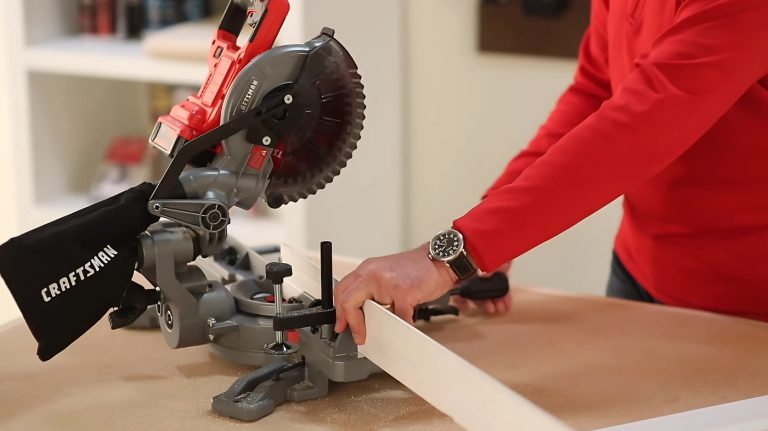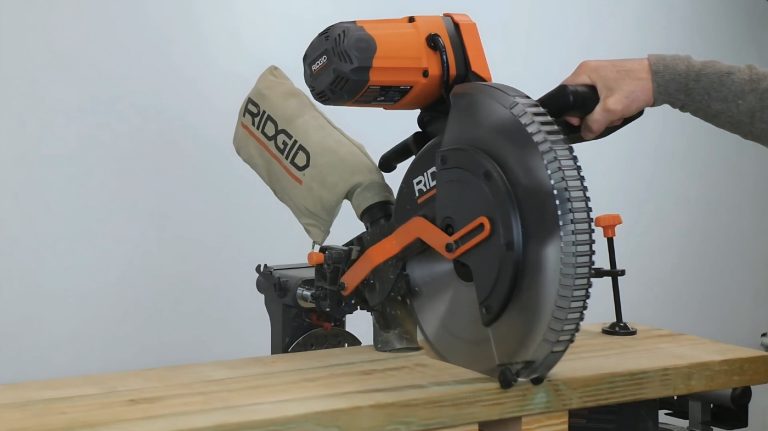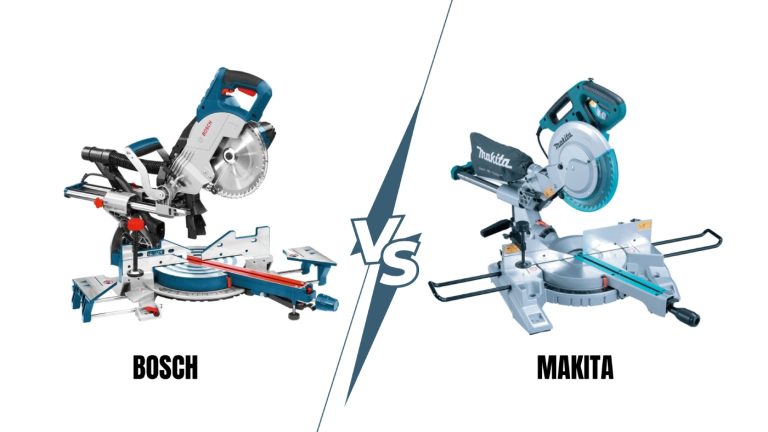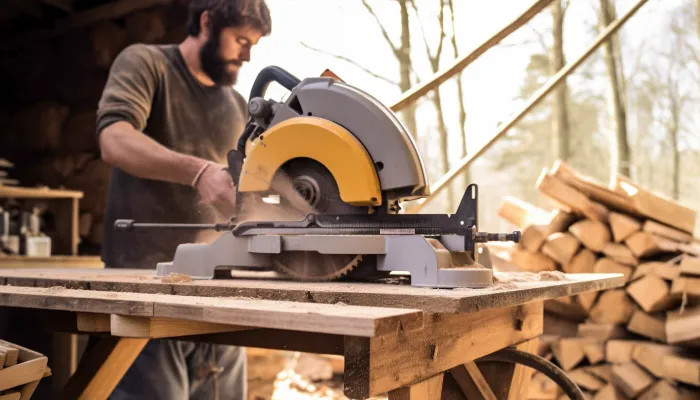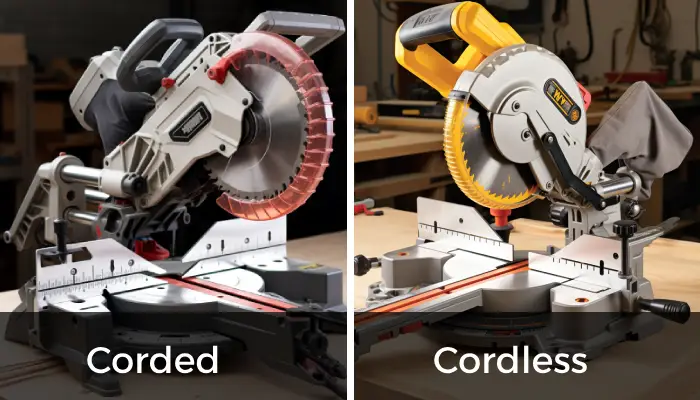Miter Saw vs Radial Arm Saw: How Do They Differ?
Are you ready to witness the ultimate battle competition between the mighty Miter Saw and the formidable Radial Arm Saw? These two beasts of the woodworking world have been pitted against each other for years, leaving craftsmen and DIY enthusiasts in a constant state of dilemma.
Both saws are capable of making cross cuts and angled cuts, but the miter saw is specifically designed for these types of cuts, offering greater precision and accuracy.
The cutting capacity of the two saws differs, with the radial arm saw typically having a greater capacity for larger and thicker materials.
In this comprehensive guide, we will explore the key differences between the Miter Saw and the Radial Arm Saw, highlighting their strengths, weaknesses, and most importantly, their suitability for beginners.
So, grab your safety goggles and join us on this epic journey as we unravel the battle of Miter Saw vs Radial Arm Saw.
The Differences Between Miter Saw vs Radial Arm Saw
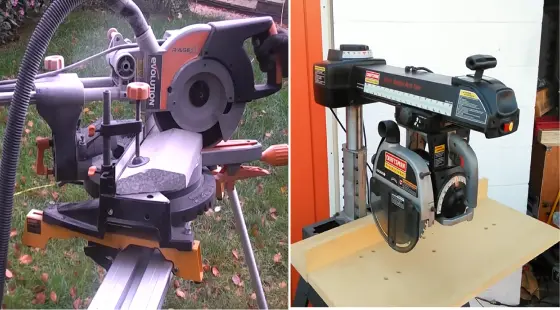
When comparing a miter saw and a radial arm saw, several key points exist. Here are the main differences between the two saws:
- Crosscuts and Angles
- Cutting Capacity Differences
- Safety Features Comparison
- Portability and Weight
- Precision and Accuracy
- Versatility in Cuts
- Ease of Use
- Cost Comparison
1. Crosscuts and Angles
Miter saw is particularly designed for fast and accurate crosscuts, miters, bevels, and compound cuts. It has a fixed blade and a side fence that provides better stability and locking rotating angles for precise adjustments.
However, radial arm saws have a circular blade mounted on a sliding arm and offer greater flexibility with the ability to rotate in different depths and angles. They offer a variety of cuts, including crosscuts, miters, bevels, compound cuts, and dadoes/rabbets, making them versatile tools for woodworking projects.
2. Cutting Capacity Differences
For smaller woodworking projects, miter saws have circular blade sizes ranging from 8 to 12 inches. They have limited cut variations and less cutting depth compared to some other saws.
On the other hand, radial arm saws have a larger blade diameter ranging from 12 to 22 inches, which is suitable for cutting thick lumber. While both power tools have their specific cutting capacities, the radial arm saw can tackle thicker materials.
3. Safety Features Comparison
Miter saws come with advanced safety features that make them a safer choice compared to radial arm saws, including a protective blade guard and a dust collector for safety. They are lightweight, portable, and customizable with extensions and clamps.
Radial arm saws are not portable, and they tend to have fewer safety features than miter saws, requiring extra caution while cutting.
4. Portability and Weight
Portable and lightweight, miter saws can be easily transported and are ideal for on-the-go woodworking projects. With their compact design and convenient handles, these saws provide the flexibility to be used in various locations. Their weight, typically ranging from 25 to 60 pounds, allows for easy maneuverability and minimizes strain on the user.
Additionally, miter saws can be customized with extensions and clamps, further enhancing their portability and versatility.
On the other hand, radial arm saws are not portable due to their heavier construction, weighing between 200 and 300 pounds. Their bulkiness and lack of handles make them less suitable for transportation.
Although radial arm saws are stationary tools, they compensate for their lack of portability with their durability and stability, making them well-suited for heavy-duty woodworking tasks within a workshop setting.
5. Precision and Accuracy
Boasting the finesse of a master painter’s brush stroke, the bevel crosscuts of the miter saw rival the precision of a surgeon’s scalpel. With its ability to make precise angled and beveled cuts, the miter saw is crucial to any woodworking project that requires accuracy.
The miter saw design allows for the blade to be adjusted to various angles, ensuring a perfect cut every time. The side fence on a radial arm saw offers stability but lacks the precision of the miter saw for angle and bevel cuts.
While the radial arm saw may be suitable for straight cuts, the miter saw’s accuracy and precision make it the preferred choice for any project that requires intricate angles or beveled cuts.
4. Versatility in Cuts
Miter saws are ideal for trimming, angular cuts, crown molding, trimming wood pieces, and framing. They have precise bevel crosscuts, making them a suitable tool for smaller woodworking projects.
In contrast, radial arm saws offer the ability to make versatile cuts, such as dadoes and rabbets, making them an excellent choice for more versatile woodworking projects.
5. Ease of Use
In addition to being relatively easy to use, miter saws produce accurate cuts, and they can be customized with extensions and clamps. They offer a side fence that provides better stability, locking rotating angles for accurate adjustments and precise cuts.
Radial arm saws are simpler to use than table saws and offer better accuracy and stability with the side fence. However, they lack precision compared to miter saws for angled/beveled cuts and may have safety concerns.
8. Cost Comparison
Miter saws are generally less expensive than radial arm saws, making them a more budget-friendly option. This is because miter saws are designed for specific types of cuts, such as crosscuts and miters, whereas radial arm saws are more versatile and can perform a wider range of cuts.
Even so, it’s worth noting that radial arm saws are still more expensive than some other power tools. So, if you’re looking for a tool that offers a good balance between cost and functionality, a miter saw might be your best bet.
9. Different Materials Cutting Capacity
Miter saws offer more cutting capacity for aluminum, wood, and plastic by using a non-ferrous metal cutting blade than radial arm saws. They are designed to handle softer materials with a low-speed motor and a powerful torque that delivers precise cuts for these types of materials.
Cutting aluminum with a radial arm saw can be challenging as it requires more power than the saw can provide, resulting in excessive pulling and tugging. So it may be difficult to make a clean and precise cut.
Whereas, miter saws have an adjustable speed feature that helps with controlling the blade’s power and reduces kickback when cutting aluminum or other soft materials.
Comparison Table Between Miter Saws and Radial Arm Saws
| Features | Miter Saws | Radial Arm Saws |
| Crosscuts | Accurate and quick | Versatile, but less precision |
| Bevels and Compound Cuts | Yes | Yes |
| Cutting Capacity | Not suitable for thick wood | Suitable for thick lumber |
| Safety Features | Advanced safety features | Fewer safety features |
| Portability and Weight | Lightweight and portable | Not portable, lighter construction |
| Precision and Accuracy | Precise for bevel crosscuts | Less precise for angled/beveled cuts |
| Versatility in Cuts | Trimming, crown molding, framing | Crosscuts, miters, bevels, compound cuts, dadoes/rabbets |
| Ease of Use | Relatively easier to use | Easier than table saws, but caution required |
What Saw for Beginners?
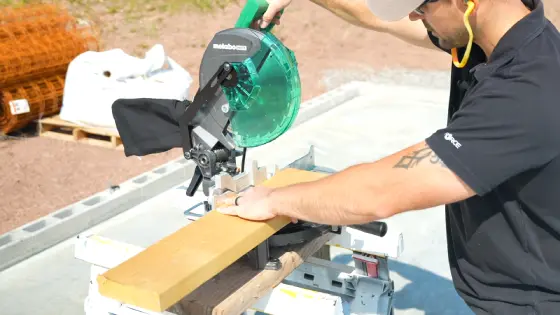
If you’re just starting out, the miter saw is the perfect tool for beginners. It allows you to effortlessly make precise cuts and envision your woodworking projects coming to life. With its easy-to-use design and intuitive controls, the miter saw offers a user-friendly experience that is ideal for those who are new to woodworking.
Plus, its compact size and lightweight construction make it portable and convenient to use in any workspace.
Here are two key advantages of the miter saw for beginners:
- Versatility: The miter saw is capable of making accurate crosscuts, miter cuts, and bevel cuts. This makes it a versatile tool for a wide range of woodworking projects.
- Safety features: Many miter saws have safety features such as blade guards and automatic blade brakes. These ensure a secure and worry-free cutting experience.
What Are the Types of Miter Saws?
In terms of miter saws, there are several types to choose from:
1. Sliding Miter Saw
With its added rails, you can easily slide the saw blade back and forth, allowing for greater reach and flexibility. This means you can tackle larger workpieces with ease, as the sliding mechanism allows for extended cutting capacity.
The sliding feature also enables you to make angled cuts with utmost accuracy, making it ideal for molding, trim work, and other detailed projects. Moreover, a sliding miter saw offers improved stability and control, always ensuring clean and smooth cuts.
With its remarkable capabilities, the sliding miter saw is a must-have tool for any serious woodworker.
2. Compound Miter Saw
This tool combines the functionality of a miter saw with the added feature of bevel cuts, allowing you to make angled cuts in addition to the standard miter cuts. With the ability to adjust both the miter and bevel angles, you have full control over the orientation and shape of your cuts.
The compound miter saw features a rotating table that allows you to make precise compound cuts at various angles, making it ideal for projects that require complex angles or intricate designs. Its compact size and portability make it a convenient tool for both professional woodworkers and hobbyists alike.
Whether you’re working on crown molding, picture frames, or furniture, the compound miter saw is a versatile and indispensable tool for achieving precise and professional results.
3. Compound Sliding Miter Saw
The compound sliding miter saw effortlessly glides along its rails, allowing for increased cross-cut capacity and precise left-bevel compound cuts. This tool combines the benefits of a miter saw and a sliding saw, providing unparalleled versatility and efficiency.
Compared to a standard miter saw, the rails allow you to make wider cross-cuts. Additionally, the left bevel feature allows for compound cuts, where the saw can tilt to create precise angled cuts on both the horizontal and vertical planes simultaneously. This capability is especially useful for crown molding and picture framing tasks.
With its smooth gliding motion and advanced cutting features, the compound sliding miter saw is ideal for any woodworking or construction project that demands accuracy and flexibility.
4. Dual Compound Sliding Miter Saw
With its dual bevel capabilities, this sliding miter saw effortlessly tackles compound cuts from both left and right angles. The miter table provides a stable platform for precise miter cuts, while the sliding rails allow for smooth and controlled movement of the saw head along the material.
The dual compound feature eliminates the need to flip the material around, saving time and effort. This saw is equipped with beveling capabilities that go left and right, allowing for a wide range of bevel cuts without needing adjustments or repositioning. You can easily switch between different angles and make intricate compound cuts with ease.
What are some popular Miter and Radial Arm Saw brand names?
The quality and durability of some power tool brands stand out above the rest. For miter saws, DEWALT, Metabo, and CRAFTSMAN are three of the most popular brands on the market.
Craftsmant produces some of the best miter saws in terms of accuracy, precision, and ease of use. Their miter saws are often favored by professional woodworkers and contractors due to their robust design and reliability.
As for radial arm saws, DEWALT once again tops the list of popular brands, along with BOSCH and WEN. DEWALT’s radial arm saws are known for their versatility and ability to make long, straight cuts with ease.
BOSCH’s radial arm saws are also highly regarded for their precision and power, while WEN is often chosen for its affordability and user-friendly features.
When choosing a miter or radial arm saw, it’s important to consider factors like blade size, power output, and overall build quality. While these top brands all offer excellent products, it’s ultimately up to the individual user to determine which saw best meets their needs and budget.
Which is safer: a miter saw or a circular saw?
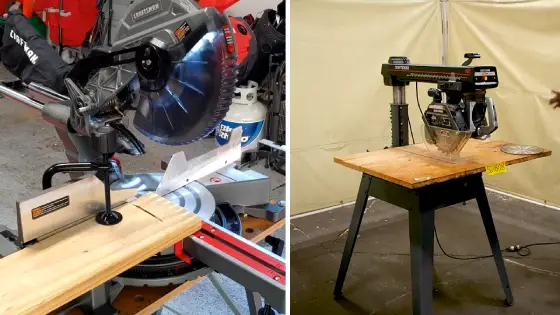
While a circular saw can make both rip cuts and cross cuts, a miter saw is designed specifically for cross cuts. This means that it has a fixed base and a rotating arm that allows the blade to make precise cuts at different angles safely.
By focusing on cross cuts only, the miter saw eliminates the need for the user to manipulate the saw during the cutting process, preventing accidental blade contact.
Additionally, miter saws often have guards to prevent blade damage and braking systems, further enhancing their overall safety. The fixed base of a miter saw provides stability and reduces the risk of the saw slipping during use.
The rotating arm allows for precise and controlled cutting, minimizing the chances of the blade veering off course. Safety features like blade guards and automatic blade braking systems add an extra layer of protection, ensuring that the blade stops quickly and safely after each cut.
Despite the fact that a circular saw may have more versatility, the limited functionality of a miter saw makes it a safer option for making cross-cuts.
What are the main parts of the radial arm saw?
Experience the power and precision of a radial arm saw, with its dynamic design and intuitive features that will revolutionize your woodworking projects.
The main parts of a radial arm saw include a circular saw blade that’s mounted radially on a stable platform, providing stability and accuracy during operation. This saw is equipped with a handle on the side, allowing for easy maneuverability and control.
Additionally, a guard is installed to ensure the worker’s safety, protecting them from potential injuries. The radial arm saws design allows for versatile cutting options, as it can be adjusted to make both crosscuts and rip cuts.
With its robust construction and precise cutting capabilities, the radial arm saw is an essential tool for any woodworking enthusiast or professional.
What is the main use of a radial arm saw?
A radial arm saw is primarily used for cutting long pieces of timber to length, making it ideal for tasks such as cross cutting and rip cutting.
The radial arm saw features several key components that enable its functionality, including a circular saw mounted on a sliding horizontal arm. The arm can be adjusted to different angles, allowing for miter cuts and bevel cuts.
Additionally, the radial arm saw can be fitted with a dado blade, which enables the creation of dado, rabbet, or half lap joints.
Miter Saw or Radial Arm Saw: Make the Right Cut
Making the right decision when choosing between a miter saw and a radial arm saw ultimately depends on your specific needs and preferences. Both saws have their own unique features and advantages, but it’s essential to consider factors such as safety, versatility, and the type of projects you’ll be working on.
While the miter saw is great for making precise angled cuts, the radial arm saw offers sturdiness and the ability to handle larger pieces of wood. So, weigh your options carefully and choose the saw that best suits your woodworking needs.

